Research Methodologies for Construction Procurement Processes
VerifiedAdded on 2020/05/28
|9
|3639
|118
Report
AI Summary
This report, submitted as part of the SRR782 course, examines research methodologies in construction procurement, focusing on the role of procurement management within the Building Information Model (BIM) context. The research aims to identify the most suitable procurement methods for construction projects, emphasizing the importance of a strong procurement team and the selection of appropriate methods based on project specifics. The report outlines the research rationale, objectives, and a detailed one-year research plan, including the development of research questions, selection of research associates, and time management considerations. It compares and contrasts deductive, inductive, and abduction research approaches, justifying the selection of the deductive approach for this study. The deductive approach is chosen for its ability to test existing theories and provide a structured framework for analyzing the implementation of BIM in enterprises. The report also explains the importance of the sequence of methods and describes a research plan for an 11-week project, detailing the chosen research approach and its application within the context of construction procurement.

Running head: 2017 TRI 3 SRR782 ASSIGNMENT 2 TEMPLATE
Student name: _Last name, First name
Student ID: 1234567
Course you are enrolled in: EgMArch
Topic: Research methodologies on Construction procurement
Student name: _Last name, First name
Student ID: 1234567
Course you are enrolled in: EgMArch
Topic: Research methodologies on Construction procurement
Paraphrase This Document
Need a fresh take? Get an instant paraphrase of this document with our AI Paraphraser
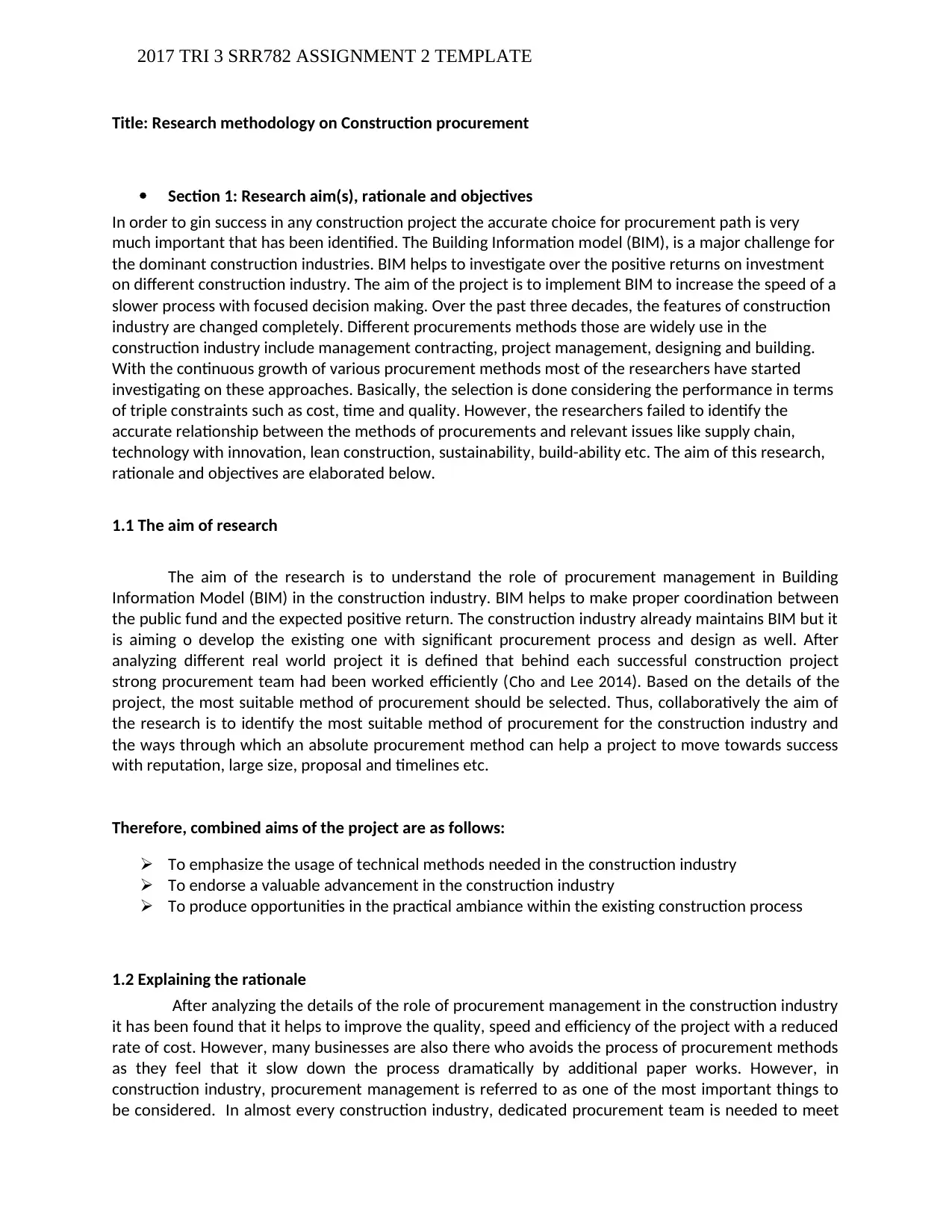
2017 TRI 3 SRR782 ASSIGNMENT 2 TEMPLATE
Title: Research methodology on Construction procurement
Section 1: Research aim(s), rationale and objectives
In order to gin success in any construction project the accurate choice for procurement path is very
much important that has been identified. The Building Information model (BIM), is a major challenge for
the dominant construction industries. BIM helps to investigate over the positive returns on investment
on different construction industry. The aim of the project is to implement BIM to increase the speed of a
slower process with focused decision making. Over the past three decades, the features of construction
industry are changed completely. Different procurements methods those are widely use in the
construction industry include management contracting, project management, designing and building.
With the continuous growth of various procurement methods most of the researchers have started
investigating on these approaches. Basically, the selection is done considering the performance in terms
of triple constraints such as cost, time and quality. However, the researchers failed to identify the
accurate relationship between the methods of procurements and relevant issues like supply chain,
technology with innovation, lean construction, sustainability, build-ability etc. The aim of this research,
rationale and objectives are elaborated below.
1.1 The aim of research
The aim of the research is to understand the role of procurement management in Building
Information Model (BIM) in the construction industry. BIM helps to make proper coordination between
the public fund and the expected positive return. The construction industry already maintains BIM but it
is aiming o develop the existing one with significant procurement process and design as well. After
analyzing different real world project it is defined that behind each successful construction project
strong procurement team had been worked efficiently (Cho and Lee 2014). Based on the details of the
project, the most suitable method of procurement should be selected. Thus, collaboratively the aim of
the research is to identify the most suitable method of procurement for the construction industry and
the ways through which an absolute procurement method can help a project to move towards success
with reputation, large size, proposal and timelines etc.
Therefore, combined aims of the project are as follows:
To emphasize the usage of technical methods needed in the construction industry
To endorse a valuable advancement in the construction industry
To produce opportunities in the practical ambiance within the existing construction process
1.2 Explaining the rationale
After analyzing the details of the role of procurement management in the construction industry
it has been found that it helps to improve the quality, speed and efficiency of the project with a reduced
rate of cost. However, many businesses are also there who avoids the process of procurement methods
as they feel that it slow down the process dramatically by additional paper works. However, in
construction industry, procurement management is referred to as one of the most important things to
be considered. In almost every construction industry, dedicated procurement team is needed to meet
Title: Research methodology on Construction procurement
Section 1: Research aim(s), rationale and objectives
In order to gin success in any construction project the accurate choice for procurement path is very
much important that has been identified. The Building Information model (BIM), is a major challenge for
the dominant construction industries. BIM helps to investigate over the positive returns on investment
on different construction industry. The aim of the project is to implement BIM to increase the speed of a
slower process with focused decision making. Over the past three decades, the features of construction
industry are changed completely. Different procurements methods those are widely use in the
construction industry include management contracting, project management, designing and building.
With the continuous growth of various procurement methods most of the researchers have started
investigating on these approaches. Basically, the selection is done considering the performance in terms
of triple constraints such as cost, time and quality. However, the researchers failed to identify the
accurate relationship between the methods of procurements and relevant issues like supply chain,
technology with innovation, lean construction, sustainability, build-ability etc. The aim of this research,
rationale and objectives are elaborated below.
1.1 The aim of research
The aim of the research is to understand the role of procurement management in Building
Information Model (BIM) in the construction industry. BIM helps to make proper coordination between
the public fund and the expected positive return. The construction industry already maintains BIM but it
is aiming o develop the existing one with significant procurement process and design as well. After
analyzing different real world project it is defined that behind each successful construction project
strong procurement team had been worked efficiently (Cho and Lee 2014). Based on the details of the
project, the most suitable method of procurement should be selected. Thus, collaboratively the aim of
the research is to identify the most suitable method of procurement for the construction industry and
the ways through which an absolute procurement method can help a project to move towards success
with reputation, large size, proposal and timelines etc.
Therefore, combined aims of the project are as follows:
To emphasize the usage of technical methods needed in the construction industry
To endorse a valuable advancement in the construction industry
To produce opportunities in the practical ambiance within the existing construction process
1.2 Explaining the rationale
After analyzing the details of the role of procurement management in the construction industry
it has been found that it helps to improve the quality, speed and efficiency of the project with a reduced
rate of cost. However, many businesses are also there who avoids the process of procurement methods
as they feel that it slow down the process dramatically by additional paper works. However, in
construction industry, procurement management is referred to as one of the most important things to
be considered. In almost every construction industry, dedicated procurement team is needed to meet
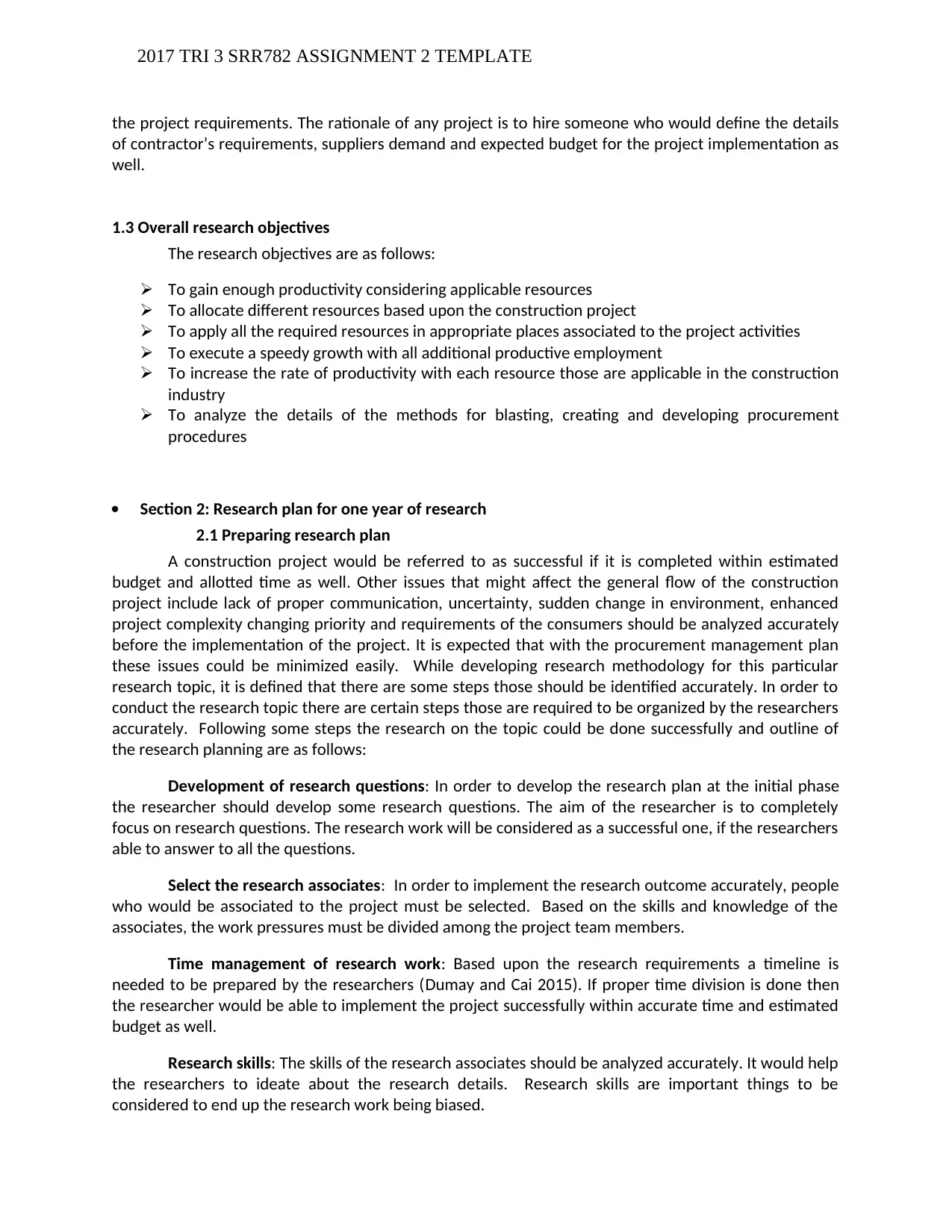
2017 TRI 3 SRR782 ASSIGNMENT 2 TEMPLATE
the project requirements. The rationale of any project is to hire someone who would define the details
of contractor’s requirements, suppliers demand and expected budget for the project implementation as
well.
1.3 Overall research objectives
The research objectives are as follows:
To gain enough productivity considering applicable resources
To allocate different resources based upon the construction project
To apply all the required resources in appropriate places associated to the project activities
To execute a speedy growth with all additional productive employment
To increase the rate of productivity with each resource those are applicable in the construction
industry
To analyze the details of the methods for blasting, creating and developing procurement
procedures
Section 2: Research plan for one year of research
2.1 Preparing research plan
A construction project would be referred to as successful if it is completed within estimated
budget and allotted time as well. Other issues that might affect the general flow of the construction
project include lack of proper communication, uncertainty, sudden change in environment, enhanced
project complexity changing priority and requirements of the consumers should be analyzed accurately
before the implementation of the project. It is expected that with the procurement management plan
these issues could be minimized easily. While developing research methodology for this particular
research topic, it is defined that there are some steps those should be identified accurately. In order to
conduct the research topic there are certain steps those are required to be organized by the researchers
accurately. Following some steps the research on the topic could be done successfully and outline of
the research planning are as follows:
Development of research questions: In order to develop the research plan at the initial phase
the researcher should develop some research questions. The aim of the researcher is to completely
focus on research questions. The research work will be considered as a successful one, if the researchers
able to answer to all the questions.
Select the research associates: In order to implement the research outcome accurately, people
who would be associated to the project must be selected. Based on the skills and knowledge of the
associates, the work pressures must be divided among the project team members.
Time management of research work: Based upon the research requirements a timeline is
needed to be prepared by the researchers (Dumay and Cai 2015). If proper time division is done then
the researcher would be able to implement the project successfully within accurate time and estimated
budget as well.
Research skills: The skills of the research associates should be analyzed accurately. It would help
the researchers to ideate about the research details. Research skills are important things to be
considered to end up the research work being biased.
the project requirements. The rationale of any project is to hire someone who would define the details
of contractor’s requirements, suppliers demand and expected budget for the project implementation as
well.
1.3 Overall research objectives
The research objectives are as follows:
To gain enough productivity considering applicable resources
To allocate different resources based upon the construction project
To apply all the required resources in appropriate places associated to the project activities
To execute a speedy growth with all additional productive employment
To increase the rate of productivity with each resource those are applicable in the construction
industry
To analyze the details of the methods for blasting, creating and developing procurement
procedures
Section 2: Research plan for one year of research
2.1 Preparing research plan
A construction project would be referred to as successful if it is completed within estimated
budget and allotted time as well. Other issues that might affect the general flow of the construction
project include lack of proper communication, uncertainty, sudden change in environment, enhanced
project complexity changing priority and requirements of the consumers should be analyzed accurately
before the implementation of the project. It is expected that with the procurement management plan
these issues could be minimized easily. While developing research methodology for this particular
research topic, it is defined that there are some steps those should be identified accurately. In order to
conduct the research topic there are certain steps those are required to be organized by the researchers
accurately. Following some steps the research on the topic could be done successfully and outline of
the research planning are as follows:
Development of research questions: In order to develop the research plan at the initial phase
the researcher should develop some research questions. The aim of the researcher is to completely
focus on research questions. The research work will be considered as a successful one, if the researchers
able to answer to all the questions.
Select the research associates: In order to implement the research outcome accurately, people
who would be associated to the project must be selected. Based on the skills and knowledge of the
associates, the work pressures must be divided among the project team members.
Time management of research work: Based upon the research requirements a timeline is
needed to be prepared by the researchers (Dumay and Cai 2015). If proper time division is done then
the researcher would be able to implement the project successfully within accurate time and estimated
budget as well.
Research skills: The skills of the research associates should be analyzed accurately. It would help
the researchers to ideate about the research details. Research skills are important things to be
considered to end up the research work being biased.
⊘ This is a preview!⊘
Do you want full access?
Subscribe today to unlock all pages.

Trusted by 1+ million students worldwide
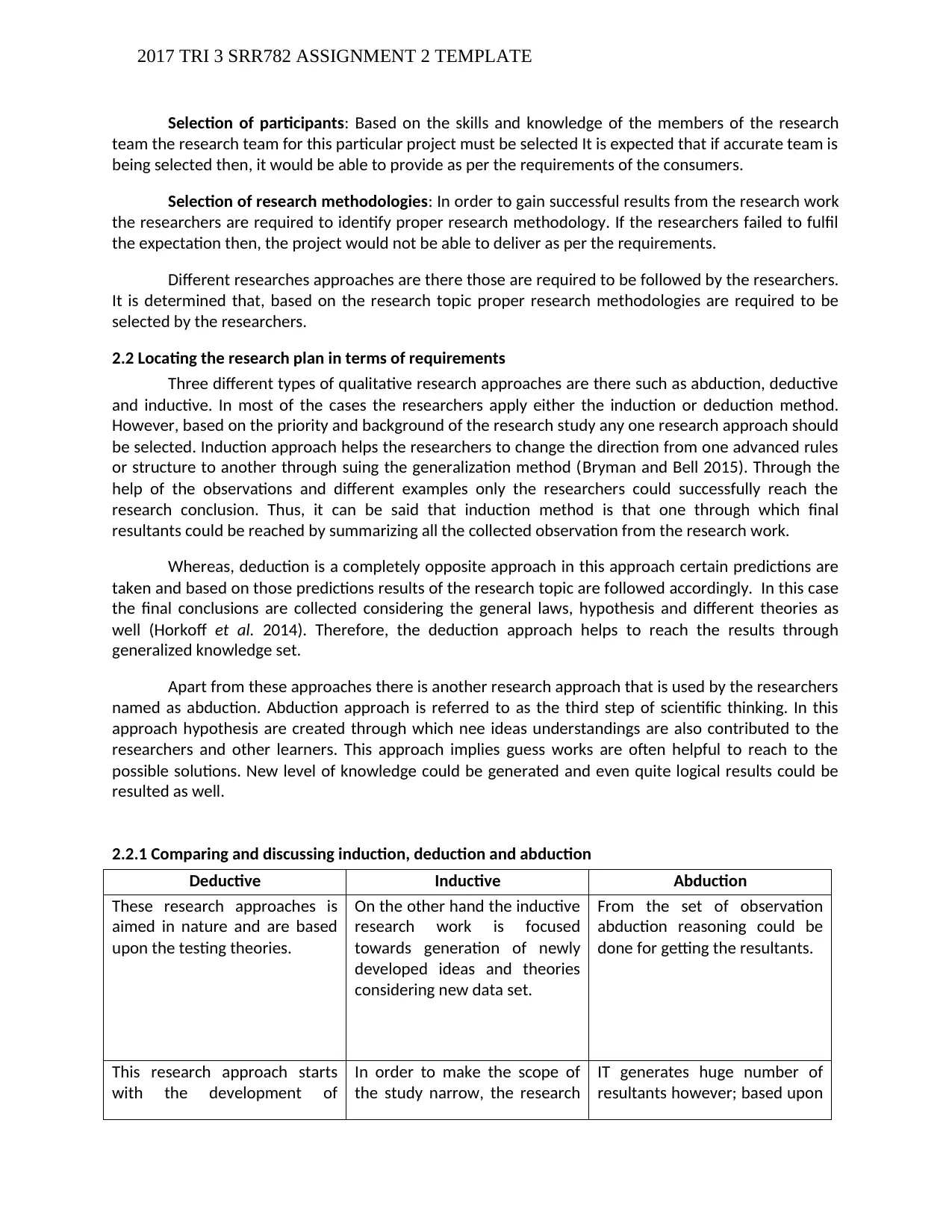
2017 TRI 3 SRR782 ASSIGNMENT 2 TEMPLATE
Selection of participants: Based on the skills and knowledge of the members of the research
team the research team for this particular project must be selected It is expected that if accurate team is
being selected then, it would be able to provide as per the requirements of the consumers.
Selection of research methodologies: In order to gain successful results from the research work
the researchers are required to identify proper research methodology. If the researchers failed to fulfil
the expectation then, the project would not be able to deliver as per the requirements.
Different researches approaches are there those are required to be followed by the researchers.
It is determined that, based on the research topic proper research methodologies are required to be
selected by the researchers.
2.2 Locating the research plan in terms of requirements
Three different types of qualitative research approaches are there such as abduction, deductive
and inductive. In most of the cases the researchers apply either the induction or deduction method.
However, based on the priority and background of the research study any one research approach should
be selected. Induction approach helps the researchers to change the direction from one advanced rules
or structure to another through suing the generalization method (Bryman and Bell 2015). Through the
help of the observations and different examples only the researchers could successfully reach the
research conclusion. Thus, it can be said that induction method is that one through which final
resultants could be reached by summarizing all the collected observation from the research work.
Whereas, deduction is a completely opposite approach in this approach certain predictions are
taken and based on those predictions results of the research topic are followed accordingly. In this case
the final conclusions are collected considering the general laws, hypothesis and different theories as
well (Horkoff et al. 2014). Therefore, the deduction approach helps to reach the results through
generalized knowledge set.
Apart from these approaches there is another research approach that is used by the researchers
named as abduction. Abduction approach is referred to as the third step of scientific thinking. In this
approach hypothesis are created through which nee ideas understandings are also contributed to the
researchers and other learners. This approach implies guess works are often helpful to reach to the
possible solutions. New level of knowledge could be generated and even quite logical results could be
resulted as well.
2.2.1 Comparing and discussing induction, deduction and abduction
Deductive Inductive Abduction
These research approaches is
aimed in nature and are based
upon the testing theories.
On the other hand the inductive
research work is focused
towards generation of newly
developed ideas and theories
considering new data set.
From the set of observation
abduction reasoning could be
done for getting the resultants.
This research approach starts
with the development of
In order to make the scope of
the study narrow, the research
IT generates huge number of
resultants however; based upon
Selection of participants: Based on the skills and knowledge of the members of the research
team the research team for this particular project must be selected It is expected that if accurate team is
being selected then, it would be able to provide as per the requirements of the consumers.
Selection of research methodologies: In order to gain successful results from the research work
the researchers are required to identify proper research methodology. If the researchers failed to fulfil
the expectation then, the project would not be able to deliver as per the requirements.
Different researches approaches are there those are required to be followed by the researchers.
It is determined that, based on the research topic proper research methodologies are required to be
selected by the researchers.
2.2 Locating the research plan in terms of requirements
Three different types of qualitative research approaches are there such as abduction, deductive
and inductive. In most of the cases the researchers apply either the induction or deduction method.
However, based on the priority and background of the research study any one research approach should
be selected. Induction approach helps the researchers to change the direction from one advanced rules
or structure to another through suing the generalization method (Bryman and Bell 2015). Through the
help of the observations and different examples only the researchers could successfully reach the
research conclusion. Thus, it can be said that induction method is that one through which final
resultants could be reached by summarizing all the collected observation from the research work.
Whereas, deduction is a completely opposite approach in this approach certain predictions are
taken and based on those predictions results of the research topic are followed accordingly. In this case
the final conclusions are collected considering the general laws, hypothesis and different theories as
well (Horkoff et al. 2014). Therefore, the deduction approach helps to reach the results through
generalized knowledge set.
Apart from these approaches there is another research approach that is used by the researchers
named as abduction. Abduction approach is referred to as the third step of scientific thinking. In this
approach hypothesis are created through which nee ideas understandings are also contributed to the
researchers and other learners. This approach implies guess works are often helpful to reach to the
possible solutions. New level of knowledge could be generated and even quite logical results could be
resulted as well.
2.2.1 Comparing and discussing induction, deduction and abduction
Deductive Inductive Abduction
These research approaches is
aimed in nature and are based
upon the testing theories.
On the other hand the inductive
research work is focused
towards generation of newly
developed ideas and theories
considering new data set.
From the set of observation
abduction reasoning could be
done for getting the resultants.
This research approach starts
with the development of
In order to make the scope of
the study narrow, the research
IT generates huge number of
resultants however; based upon
Paraphrase This Document
Need a fresh take? Get an instant paraphrase of this document with our AI Paraphraser
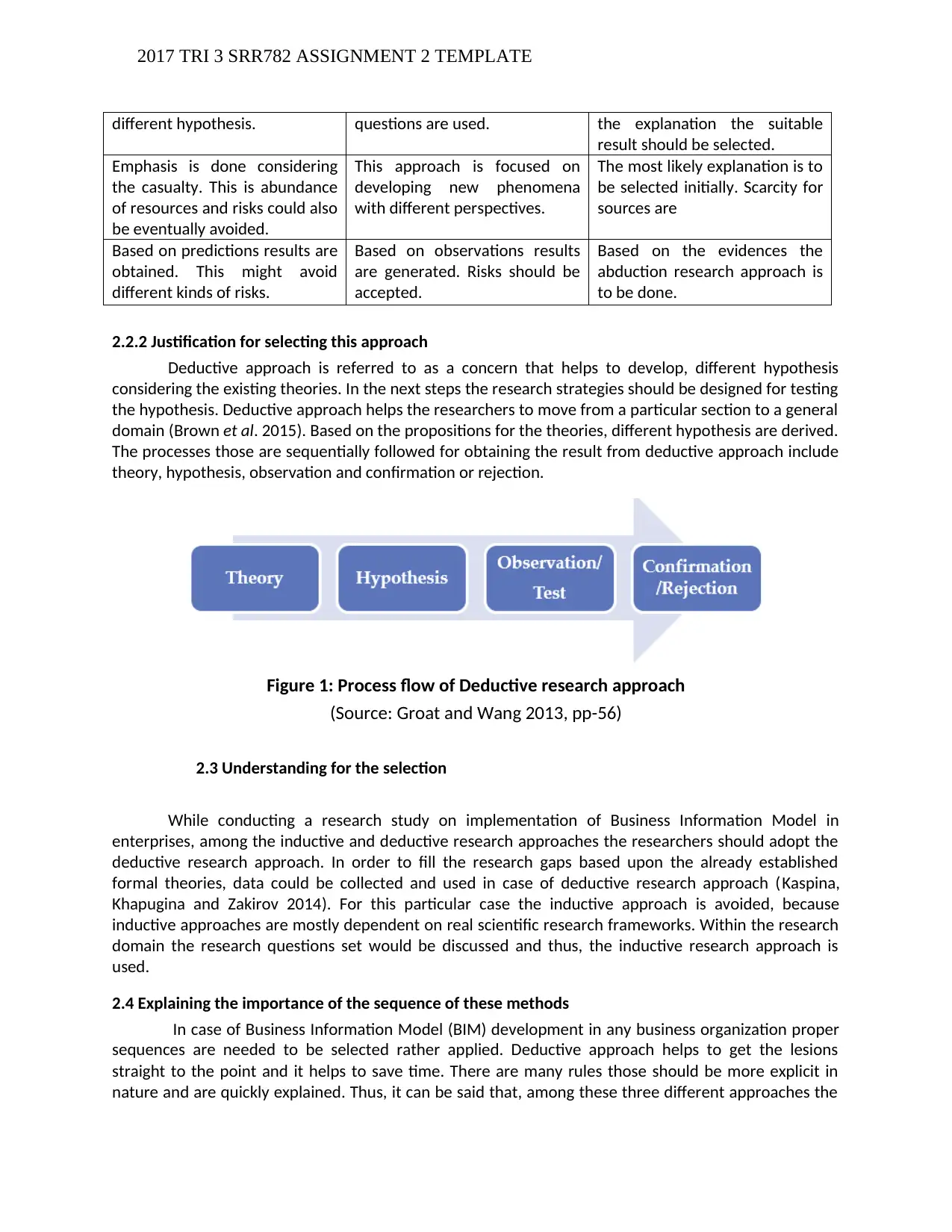
2017 TRI 3 SRR782 ASSIGNMENT 2 TEMPLATE
different hypothesis. questions are used. the explanation the suitable
result should be selected.
Emphasis is done considering
the casualty. This is abundance
of resources and risks could also
be eventually avoided.
This approach is focused on
developing new phenomena
with different perspectives.
The most likely explanation is to
be selected initially. Scarcity for
sources are
Based on predictions results are
obtained. This might avoid
different kinds of risks.
Based on observations results
are generated. Risks should be
accepted.
Based on the evidences the
abduction research approach is
to be done.
2.2.2 Justification for selecting this approach
Deductive approach is referred to as a concern that helps to develop, different hypothesis
considering the existing theories. In the next steps the research strategies should be designed for testing
the hypothesis. Deductive approach helps the researchers to move from a particular section to a general
domain (Brown et al. 2015). Based on the propositions for the theories, different hypothesis are derived.
The processes those are sequentially followed for obtaining the result from deductive approach include
theory, hypothesis, observation and confirmation or rejection.
Figure 1: Process flow of Deductive research approach
(Source: Groat and Wang 2013, pp-56)
2.3 Understanding for the selection
While conducting a research study on implementation of Business Information Model in
enterprises, among the inductive and deductive research approaches the researchers should adopt the
deductive research approach. In order to fill the research gaps based upon the already established
formal theories, data could be collected and used in case of deductive research approach (Kaspina,
Khapugina and Zakirov 2014). For this particular case the inductive approach is avoided, because
inductive approaches are mostly dependent on real scientific research frameworks. Within the research
domain the research questions set would be discussed and thus, the inductive research approach is
used.
2.4 Explaining the importance of the sequence of these methods
In case of Business Information Model (BIM) development in any business organization proper
sequences are needed to be selected rather applied. Deductive approach helps to get the lesions
straight to the point and it helps to save time. There are many rules those should be more explicit in
nature and are quickly explained. Thus, it can be said that, among these three different approaches the
different hypothesis. questions are used. the explanation the suitable
result should be selected.
Emphasis is done considering
the casualty. This is abundance
of resources and risks could also
be eventually avoided.
This approach is focused on
developing new phenomena
with different perspectives.
The most likely explanation is to
be selected initially. Scarcity for
sources are
Based on predictions results are
obtained. This might avoid
different kinds of risks.
Based on observations results
are generated. Risks should be
accepted.
Based on the evidences the
abduction research approach is
to be done.
2.2.2 Justification for selecting this approach
Deductive approach is referred to as a concern that helps to develop, different hypothesis
considering the existing theories. In the next steps the research strategies should be designed for testing
the hypothesis. Deductive approach helps the researchers to move from a particular section to a general
domain (Brown et al. 2015). Based on the propositions for the theories, different hypothesis are derived.
The processes those are sequentially followed for obtaining the result from deductive approach include
theory, hypothesis, observation and confirmation or rejection.
Figure 1: Process flow of Deductive research approach
(Source: Groat and Wang 2013, pp-56)
2.3 Understanding for the selection
While conducting a research study on implementation of Business Information Model in
enterprises, among the inductive and deductive research approaches the researchers should adopt the
deductive research approach. In order to fill the research gaps based upon the already established
formal theories, data could be collected and used in case of deductive research approach (Kaspina,
Khapugina and Zakirov 2014). For this particular case the inductive approach is avoided, because
inductive approaches are mostly dependent on real scientific research frameworks. Within the research
domain the research questions set would be discussed and thus, the inductive research approach is
used.
2.4 Explaining the importance of the sequence of these methods
In case of Business Information Model (BIM) development in any business organization proper
sequences are needed to be selected rather applied. Deductive approach helps to get the lesions
straight to the point and it helps to save time. There are many rules those should be more explicit in
nature and are quickly explained. Thus, it can be said that, among these three different approaches the
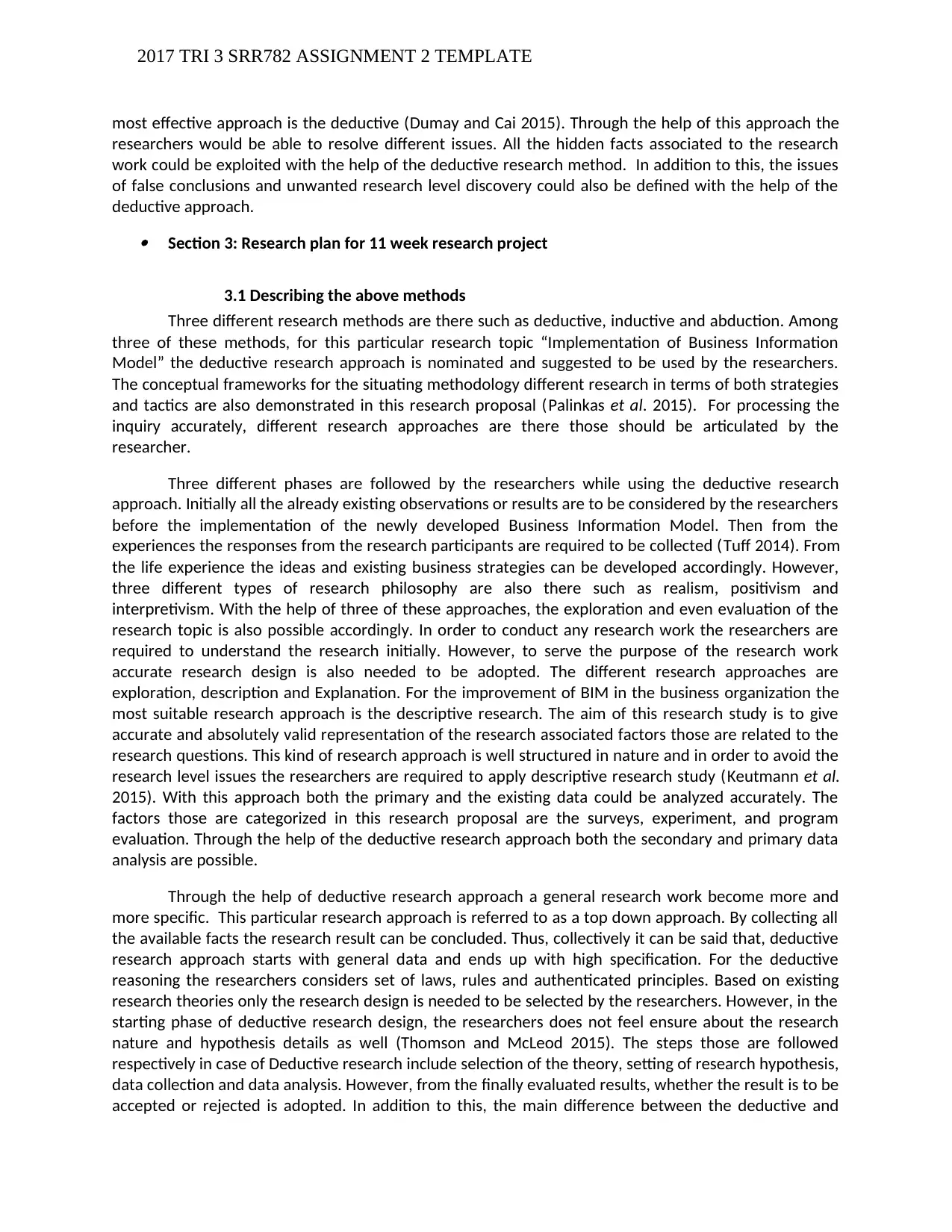
2017 TRI 3 SRR782 ASSIGNMENT 2 TEMPLATE
most effective approach is the deductive (Dumay and Cai 2015). Through the help of this approach the
researchers would be able to resolve different issues. All the hidden facts associated to the research
work could be exploited with the help of the deductive research method. In addition to this, the issues
of false conclusions and unwanted research level discovery could also be defined with the help of the
deductive approach. Section 3: Research plan for 11 week research project
3.1 Describing the above methods
Three different research methods are there such as deductive, inductive and abduction. Among
three of these methods, for this particular research topic “Implementation of Business Information
Model” the deductive research approach is nominated and suggested to be used by the researchers.
The conceptual frameworks for the situating methodology different research in terms of both strategies
and tactics are also demonstrated in this research proposal (Palinkas et al. 2015). For processing the
inquiry accurately, different research approaches are there those should be articulated by the
researcher.
Three different phases are followed by the researchers while using the deductive research
approach. Initially all the already existing observations or results are to be considered by the researchers
before the implementation of the newly developed Business Information Model. Then from the
experiences the responses from the research participants are required to be collected (Tuff 2014). From
the life experience the ideas and existing business strategies can be developed accordingly. However,
three different types of research philosophy are also there such as realism, positivism and
interpretivism. With the help of three of these approaches, the exploration and even evaluation of the
research topic is also possible accordingly. In order to conduct any research work the researchers are
required to understand the research initially. However, to serve the purpose of the research work
accurate research design is also needed to be adopted. The different research approaches are
exploration, description and Explanation. For the improvement of BIM in the business organization the
most suitable research approach is the descriptive research. The aim of this research study is to give
accurate and absolutely valid representation of the research associated factors those are related to the
research questions. This kind of research approach is well structured in nature and in order to avoid the
research level issues the researchers are required to apply descriptive research study (Keutmann et al.
2015). With this approach both the primary and the existing data could be analyzed accurately. The
factors those are categorized in this research proposal are the surveys, experiment, and program
evaluation. Through the help of the deductive research approach both the secondary and primary data
analysis are possible.
Through the help of deductive research approach a general research work become more and
more specific. This particular research approach is referred to as a top down approach. By collecting all
the available facts the research result can be concluded. Thus, collectively it can be said that, deductive
research approach starts with general data and ends up with high specification. For the deductive
reasoning the researchers considers set of laws, rules and authenticated principles. Based on existing
research theories only the research design is needed to be selected by the researchers. However, in the
starting phase of deductive research design, the researchers does not feel ensure about the research
nature and hypothesis details as well (Thomson and McLeod 2015). The steps those are followed
respectively in case of Deductive research include selection of the theory, setting of research hypothesis,
data collection and data analysis. However, from the finally evaluated results, whether the result is to be
accepted or rejected is adopted. In addition to this, the main difference between the deductive and
most effective approach is the deductive (Dumay and Cai 2015). Through the help of this approach the
researchers would be able to resolve different issues. All the hidden facts associated to the research
work could be exploited with the help of the deductive research method. In addition to this, the issues
of false conclusions and unwanted research level discovery could also be defined with the help of the
deductive approach. Section 3: Research plan for 11 week research project
3.1 Describing the above methods
Three different research methods are there such as deductive, inductive and abduction. Among
three of these methods, for this particular research topic “Implementation of Business Information
Model” the deductive research approach is nominated and suggested to be used by the researchers.
The conceptual frameworks for the situating methodology different research in terms of both strategies
and tactics are also demonstrated in this research proposal (Palinkas et al. 2015). For processing the
inquiry accurately, different research approaches are there those should be articulated by the
researcher.
Three different phases are followed by the researchers while using the deductive research
approach. Initially all the already existing observations or results are to be considered by the researchers
before the implementation of the newly developed Business Information Model. Then from the
experiences the responses from the research participants are required to be collected (Tuff 2014). From
the life experience the ideas and existing business strategies can be developed accordingly. However,
three different types of research philosophy are also there such as realism, positivism and
interpretivism. With the help of three of these approaches, the exploration and even evaluation of the
research topic is also possible accordingly. In order to conduct any research work the researchers are
required to understand the research initially. However, to serve the purpose of the research work
accurate research design is also needed to be adopted. The different research approaches are
exploration, description and Explanation. For the improvement of BIM in the business organization the
most suitable research approach is the descriptive research. The aim of this research study is to give
accurate and absolutely valid representation of the research associated factors those are related to the
research questions. This kind of research approach is well structured in nature and in order to avoid the
research level issues the researchers are required to apply descriptive research study (Keutmann et al.
2015). With this approach both the primary and the existing data could be analyzed accurately. The
factors those are categorized in this research proposal are the surveys, experiment, and program
evaluation. Through the help of the deductive research approach both the secondary and primary data
analysis are possible.
Through the help of deductive research approach a general research work become more and
more specific. This particular research approach is referred to as a top down approach. By collecting all
the available facts the research result can be concluded. Thus, collectively it can be said that, deductive
research approach starts with general data and ends up with high specification. For the deductive
reasoning the researchers considers set of laws, rules and authenticated principles. Based on existing
research theories only the research design is needed to be selected by the researchers. However, in the
starting phase of deductive research design, the researchers does not feel ensure about the research
nature and hypothesis details as well (Thomson and McLeod 2015). The steps those are followed
respectively in case of Deductive research include selection of the theory, setting of research hypothesis,
data collection and data analysis. However, from the finally evaluated results, whether the result is to be
accepted or rejected is adopted. In addition to this, the main difference between the deductive and
⊘ This is a preview!⊘
Do you want full access?
Subscribe today to unlock all pages.

Trusted by 1+ million students worldwide
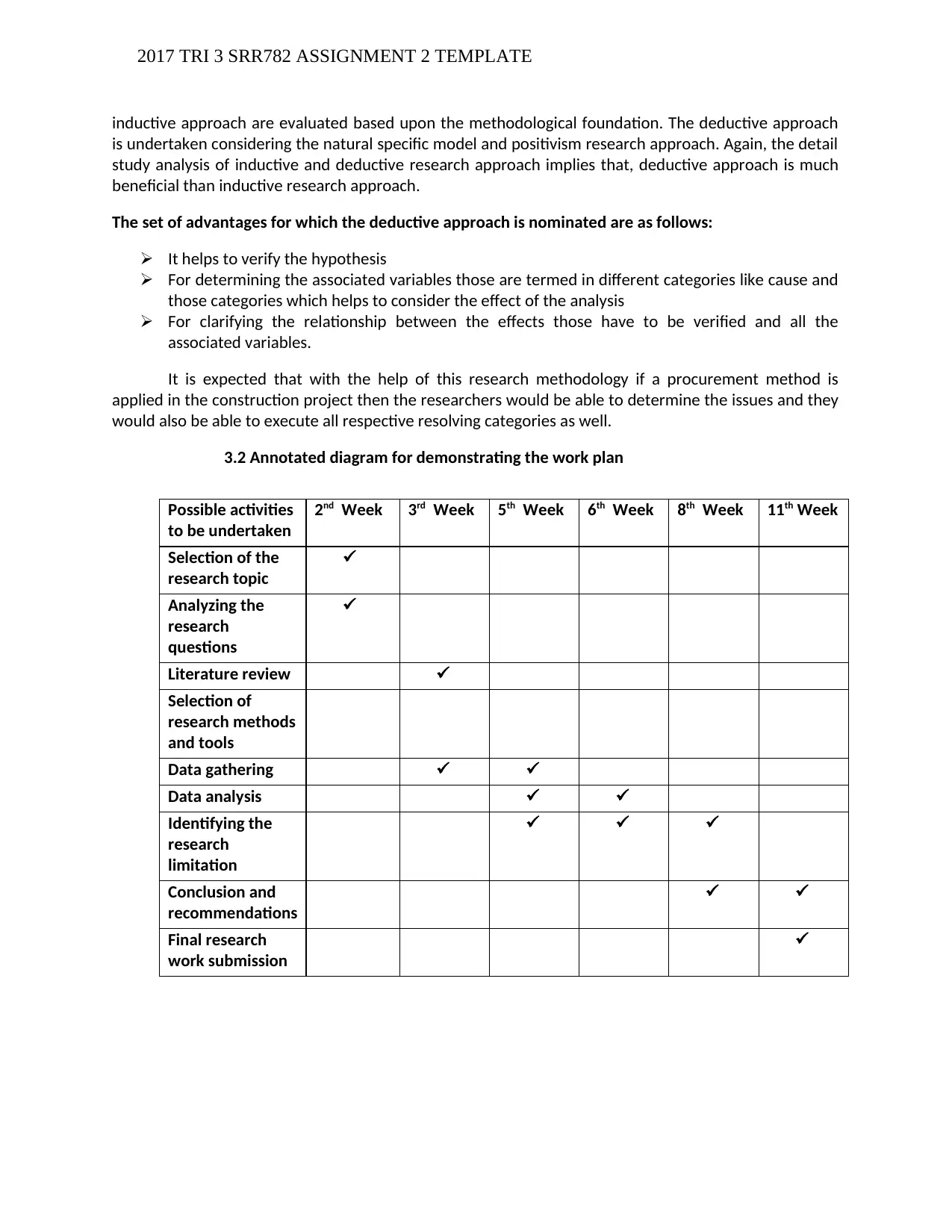
2017 TRI 3 SRR782 ASSIGNMENT 2 TEMPLATE
inductive approach are evaluated based upon the methodological foundation. The deductive approach
is undertaken considering the natural specific model and positivism research approach. Again, the detail
study analysis of inductive and deductive research approach implies that, deductive approach is much
beneficial than inductive research approach.
The set of advantages for which the deductive approach is nominated are as follows:
It helps to verify the hypothesis
For determining the associated variables those are termed in different categories like cause and
those categories which helps to consider the effect of the analysis
For clarifying the relationship between the effects those have to be verified and all the
associated variables.
It is expected that with the help of this research methodology if a procurement method is
applied in the construction project then the researchers would be able to determine the issues and they
would also be able to execute all respective resolving categories as well.
3.2 Annotated diagram for demonstrating the work plan
Possible activities
to be undertaken
2nd Week 3rd Week 5th Week 6th Week 8th Week 11th Week
Selection of the
research topic
Analyzing the
research
questions
Literature review
Selection of
research methods
and tools
Data gathering
Data analysis
Identifying the
research
limitation
Conclusion and
recommendations
Final research
work submission
inductive approach are evaluated based upon the methodological foundation. The deductive approach
is undertaken considering the natural specific model and positivism research approach. Again, the detail
study analysis of inductive and deductive research approach implies that, deductive approach is much
beneficial than inductive research approach.
The set of advantages for which the deductive approach is nominated are as follows:
It helps to verify the hypothesis
For determining the associated variables those are termed in different categories like cause and
those categories which helps to consider the effect of the analysis
For clarifying the relationship between the effects those have to be verified and all the
associated variables.
It is expected that with the help of this research methodology if a procurement method is
applied in the construction project then the researchers would be able to determine the issues and they
would also be able to execute all respective resolving categories as well.
3.2 Annotated diagram for demonstrating the work plan
Possible activities
to be undertaken
2nd Week 3rd Week 5th Week 6th Week 8th Week 11th Week
Selection of the
research topic
Analyzing the
research
questions
Literature review
Selection of
research methods
and tools
Data gathering
Data analysis
Identifying the
research
limitation
Conclusion and
recommendations
Final research
work submission
Paraphrase This Document
Need a fresh take? Get an instant paraphrase of this document with our AI Paraphraser
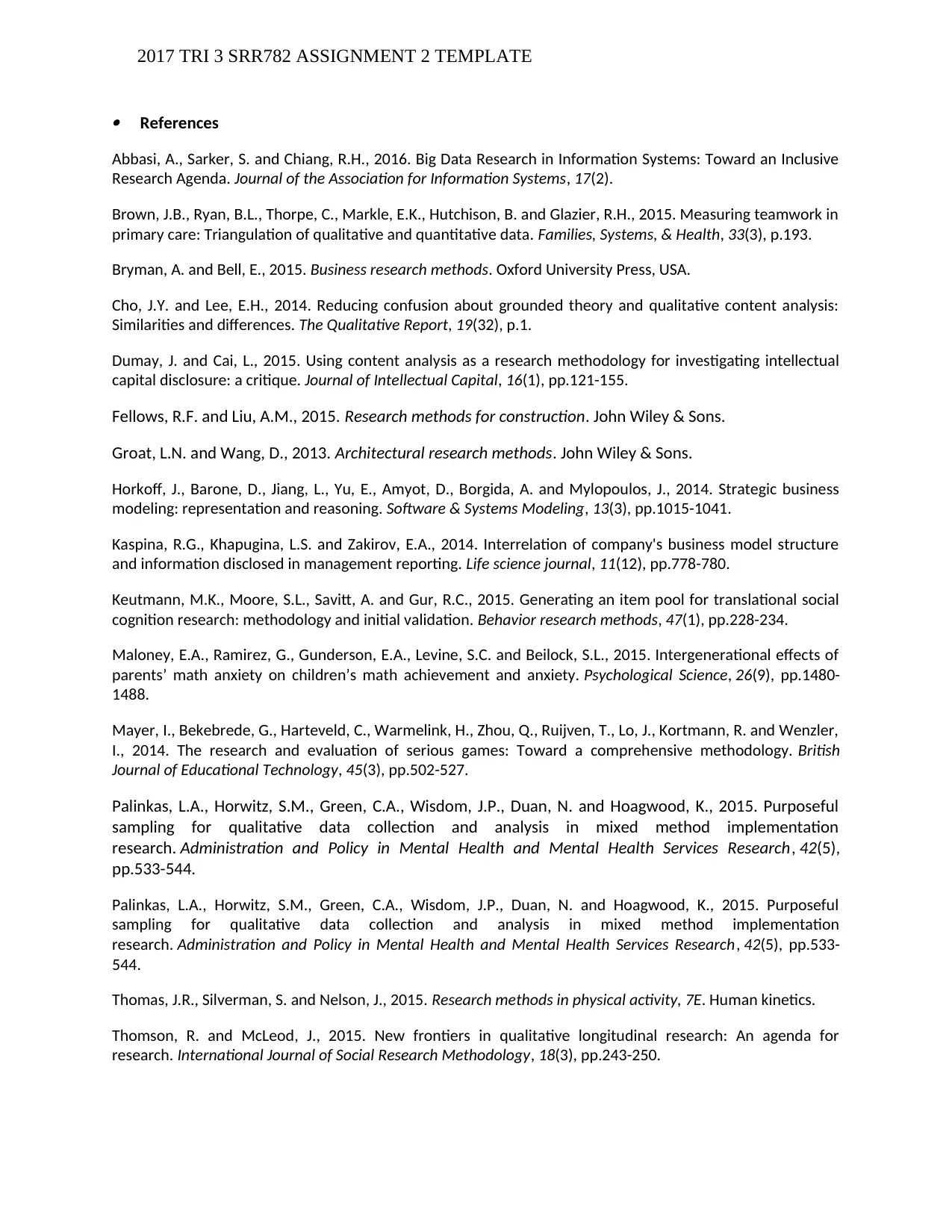
2017 TRI 3 SRR782 ASSIGNMENT 2 TEMPLATE
References
Abbasi, A., Sarker, S. and Chiang, R.H., 2016. Big Data Research in Information Systems: Toward an Inclusive
Research Agenda. Journal of the Association for Information Systems, 17(2).
Brown, J.B., Ryan, B.L., Thorpe, C., Markle, E.K., Hutchison, B. and Glazier, R.H., 2015. Measuring teamwork in
primary care: Triangulation of qualitative and quantitative data. Families, Systems, & Health, 33(3), p.193.
Bryman, A. and Bell, E., 2015. Business research methods. Oxford University Press, USA.
Cho, J.Y. and Lee, E.H., 2014. Reducing confusion about grounded theory and qualitative content analysis:
Similarities and differences. The Qualitative Report, 19(32), p.1.
Dumay, J. and Cai, L., 2015. Using content analysis as a research methodology for investigating intellectual
capital disclosure: a critique. Journal of Intellectual Capital, 16(1), pp.121-155.
Fellows, R.F. and Liu, A.M., 2015. Research methods for construction. John Wiley & Sons.
Groat, L.N. and Wang, D., 2013. Architectural research methods. John Wiley & Sons.
Horkoff, J., Barone, D., Jiang, L., Yu, E., Amyot, D., Borgida, A. and Mylopoulos, J., 2014. Strategic business
modeling: representation and reasoning. Software & Systems Modeling, 13(3), pp.1015-1041.
Kaspina, R.G., Khapugina, L.S. and Zakirov, E.A., 2014. Interrelation of company's business model structure
and information disclosed in management reporting. Life science journal, 11(12), pp.778-780.
Keutmann, M.K., Moore, S.L., Savitt, A. and Gur, R.C., 2015. Generating an item pool for translational social
cognition research: methodology and initial validation. Behavior research methods, 47(1), pp.228-234.
Maloney, E.A., Ramirez, G., Gunderson, E.A., Levine, S.C. and Beilock, S.L., 2015. Intergenerational effects of
parents’ math anxiety on children’s math achievement and anxiety. Psychological Science, 26(9), pp.1480-
1488.
Mayer, I., Bekebrede, G., Harteveld, C., Warmelink, H., Zhou, Q., Ruijven, T., Lo, J., Kortmann, R. and Wenzler,
I., 2014. The research and evaluation of serious games: Toward a comprehensive methodology. British
Journal of Educational Technology, 45(3), pp.502-527.
Palinkas, L.A., Horwitz, S.M., Green, C.A., Wisdom, J.P., Duan, N. and Hoagwood, K., 2015. Purposeful
sampling for qualitative data collection and analysis in mixed method implementation
research. Administration and Policy in Mental Health and Mental Health Services Research, 42(5),
pp.533-544.
Palinkas, L.A., Horwitz, S.M., Green, C.A., Wisdom, J.P., Duan, N. and Hoagwood, K., 2015. Purposeful
sampling for qualitative data collection and analysis in mixed method implementation
research. Administration and Policy in Mental Health and Mental Health Services Research, 42(5), pp.533-
544.
Thomas, J.R., Silverman, S. and Nelson, J., 2015. Research methods in physical activity, 7E. Human kinetics.
Thomson, R. and McLeod, J., 2015. New frontiers in qualitative longitudinal research: An agenda for
research. International Journal of Social Research Methodology, 18(3), pp.243-250.
References
Abbasi, A., Sarker, S. and Chiang, R.H., 2016. Big Data Research in Information Systems: Toward an Inclusive
Research Agenda. Journal of the Association for Information Systems, 17(2).
Brown, J.B., Ryan, B.L., Thorpe, C., Markle, E.K., Hutchison, B. and Glazier, R.H., 2015. Measuring teamwork in
primary care: Triangulation of qualitative and quantitative data. Families, Systems, & Health, 33(3), p.193.
Bryman, A. and Bell, E., 2015. Business research methods. Oxford University Press, USA.
Cho, J.Y. and Lee, E.H., 2014. Reducing confusion about grounded theory and qualitative content analysis:
Similarities and differences. The Qualitative Report, 19(32), p.1.
Dumay, J. and Cai, L., 2015. Using content analysis as a research methodology for investigating intellectual
capital disclosure: a critique. Journal of Intellectual Capital, 16(1), pp.121-155.
Fellows, R.F. and Liu, A.M., 2015. Research methods for construction. John Wiley & Sons.
Groat, L.N. and Wang, D., 2013. Architectural research methods. John Wiley & Sons.
Horkoff, J., Barone, D., Jiang, L., Yu, E., Amyot, D., Borgida, A. and Mylopoulos, J., 2014. Strategic business
modeling: representation and reasoning. Software & Systems Modeling, 13(3), pp.1015-1041.
Kaspina, R.G., Khapugina, L.S. and Zakirov, E.A., 2014. Interrelation of company's business model structure
and information disclosed in management reporting. Life science journal, 11(12), pp.778-780.
Keutmann, M.K., Moore, S.L., Savitt, A. and Gur, R.C., 2015. Generating an item pool for translational social
cognition research: methodology and initial validation. Behavior research methods, 47(1), pp.228-234.
Maloney, E.A., Ramirez, G., Gunderson, E.A., Levine, S.C. and Beilock, S.L., 2015. Intergenerational effects of
parents’ math anxiety on children’s math achievement and anxiety. Psychological Science, 26(9), pp.1480-
1488.
Mayer, I., Bekebrede, G., Harteveld, C., Warmelink, H., Zhou, Q., Ruijven, T., Lo, J., Kortmann, R. and Wenzler,
I., 2014. The research and evaluation of serious games: Toward a comprehensive methodology. British
Journal of Educational Technology, 45(3), pp.502-527.
Palinkas, L.A., Horwitz, S.M., Green, C.A., Wisdom, J.P., Duan, N. and Hoagwood, K., 2015. Purposeful
sampling for qualitative data collection and analysis in mixed method implementation
research. Administration and Policy in Mental Health and Mental Health Services Research, 42(5),
pp.533-544.
Palinkas, L.A., Horwitz, S.M., Green, C.A., Wisdom, J.P., Duan, N. and Hoagwood, K., 2015. Purposeful
sampling for qualitative data collection and analysis in mixed method implementation
research. Administration and Policy in Mental Health and Mental Health Services Research, 42(5), pp.533-
544.
Thomas, J.R., Silverman, S. and Nelson, J., 2015. Research methods in physical activity, 7E. Human kinetics.
Thomson, R. and McLeod, J., 2015. New frontiers in qualitative longitudinal research: An agenda for
research. International Journal of Social Research Methodology, 18(3), pp.243-250.

2017 TRI 3 SRR782 ASSIGNMENT 2 TEMPLATE
Trainor, K.J., Andzulis, J.M., Rapp, A. and Agnihotri, R., 2014. Social media technology usage and customer
relationship performance: A capabilities-based examination of social CRM. Journal of Business
Research, 67(6), pp.1201-1208.
Tuff, L., 2014. Court Appointed Special Advocates: Is their impact effectively evaluated by current research
methodology?.
Trainor, K.J., Andzulis, J.M., Rapp, A. and Agnihotri, R., 2014. Social media technology usage and customer
relationship performance: A capabilities-based examination of social CRM. Journal of Business
Research, 67(6), pp.1201-1208.
Tuff, L., 2014. Court Appointed Special Advocates: Is their impact effectively evaluated by current research
methodology?.
⊘ This is a preview!⊘
Do you want full access?
Subscribe today to unlock all pages.

Trusted by 1+ million students worldwide
1 out of 9
Related Documents
Your All-in-One AI-Powered Toolkit for Academic Success.
+13062052269
info@desklib.com
Available 24*7 on WhatsApp / Email
![[object Object]](/_next/static/media/star-bottom.7253800d.svg)
Unlock your academic potential
Copyright © 2020–2025 A2Z Services. All Rights Reserved. Developed and managed by ZUCOL.





